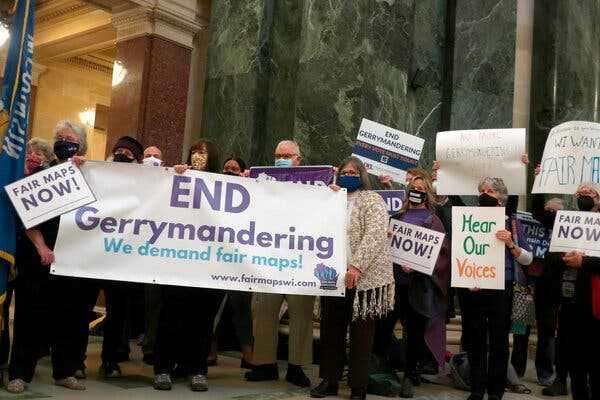The justices sent a case on legislative maps back to a state court for another look, but they refused a request to block the state’s congressional maps.
-
Send any friend a story
As a subscriber, you have “>10 gift articles to give each month. Anyone can read what you share.
Give this article
- 3
- Read in app

A rally in October in Madison, Wis., where Gov. Tony Evers and Republican leaders are battling over redistricting.
WASHINGTON — The Supreme Court sided with Wisconsin’s Republican-led Legislature on Wednesday in a dispute over competing voting maps for the state’s legislative districts.
The justices’ unsigned order reversed a ruling from the Wisconsin Supreme Court that had selected the map drawn by Gov. Tony Evers over other proposals, and it sent the case back to the state court for another look.
The majority said the state court had not considered carefully enough whether the Voting Rights Act, a federal law that protects minority voting power, required the addition of a seventh assembly district in which Black voters made up a majority.
Justice Sonia Sotomayor, joined by Justice Elena Kagan, dissented, saying that “the court’s action today is unprecedented.” She added that “the court today faults the State Supreme Court for its failure to comply with an obligation that, under existing precedent, is hazy at best.”
In an emergency application to the U.S. Supreme Court, lawyers for the Legislature and four voters called the governor’s map a “21st-century racial gerrymander,” focusing on the fact that it increased the number of State Assembly districts around Milwaukee in which Black voters made up a majority to seven from six. The Legislature’s map dropped the number to five.
They argued that “maximization of majority-minority districts in a redistricting plan” was unconstitutional, noting that the seven districts in the governor’s plan all had bare majorities of Black voters.
Justice Brian Hagedorn, writing for the majority in the Wisconsin Supreme Court’s 4-to-3 decision, indicated that the question was in some ways a close one.
What to Know About Redistricting
- Redistricting, Explained: Here are some answers to your most pressing questions about the process that is reshaping American politics.
- Understand Gerrymandering: Can you gerrymander your party to power? Try to draw your own districts in this imaginary state.
- Analysis: For years, the congressional map favored Republicans over Democrats. But in 2022, the map is poised to be surprisingly fair.
- Killing Competition: The number of competitive districts is dropping, as both parties use redistricting to draw themselves into safe seats.
“We cannot say for certain on this record,” he wrote, “that seven majority-Black assembly districts are required” by the Voting Rights Act. “But based on our assessment of the totality of the circumstances and given the discretion afforded states implementing the act, we conclude the governor’s configuration is permissible.”
But Justice Hagedorn added that a map with fewer majority-Black districts could impermissibly pack Black voters into some districts, diluting their power.
In dissent, Justice Annette Kingsland Ziegler wrote that Mr. Evers had overemphasized race in drawing his map.
“History is littered with racial animus, hostility, discrimination” and disparate treatment, she wrote. “The equal protection clause demands that governments in the United States rise above the human temptation of dividing by race and treat individuals how basic dignity demands they be treated: as individuals.”
In response, lawyers for Mr. Evers said that the Legislature and the voters who filed the emergency application had not suffered the sort of direct injury that gave them standing to sue; that it was too late for the Supreme Court to intervene given the preparations needed for this year’s elections; and that it was not the Supreme Court’s role to serve as “the map-drawer for Wisconsin.”
The Supreme Court has already agreed to consider the role race may play in drawing voting districts in a case from Alabama that it will hear in its next term, which starts in October. In that case, Merrill v. Milligan, No. 21- 1086, the court reinstated a congressional map that had been drawn by the State Legislature, blocking a ruling from a federal court that the map diluted the power of Black voters.
The Alabama case differed from the Wisconsin one in at least two ways: It involved federal rather than state elections and a ruling from a federal rather than a state court.
In a second unsigned order on Wednesday, without noted dissents, the court rejected a separate emergency application concerning Wisconsin’s congressional districts.
How U.S. Redistricting Works
Card 1 of 8
What is redistricting? It’s the redrawing of the boundaries of congressional and state legislative districts. It happens every 10 years, after the census, to reflect changes in population.
Why is it important this year? With an extremely slim Democratic margin in the House of Representatives, simply redrawing maps in a few key states could determine control of Congress in 2022.
How does it work? The census dictates how many seats in Congress each state will get. Mapmakers then work to ensure that a state’s districts all have roughly the same number of residents, to ensure equal representation in the House.
Who draws the new maps? Each state has its own process. Eleven states leave the mapmaking to an outside panel. But most — 39 states — have state lawmakers draw the new maps for Congress.
If state legislators can draw their own districts, won’t they be biased? Yes. Partisan mapmakers often move district lines — subtly or egregiously — to cluster voters in a way that advances a political goal. This is called gerrymandering.
What is gerrymandering? It refers to the intentional distortion of district maps to give one party an advantage. While all districts must have roughly the same population, mapmakers can make subjective decisions to create a partisan tilt.
Is gerrymandering legal? Yes and no. In 2019, the Supreme Court ruled that the federal courts have no role to play in blocking partisan gerrymanders. However, the court left intact parts of the Voting Rights Act that prohibit racial or ethnic gerrymandering.
Want to know more about redistricting and gerrymandering? Times reporters answer your most pressing questions here.
The practical consequences of the order were likely to be minor, as the State Supreme Court said it chose the new congressional map because it hewed most closely to one drawn by Republicans in 2011. The state’s House delegation is currently split 5 to 3 in favor of Republicans.
The congressmen said the Wisconsin Supreme Court had performed a bait-and-switch in soliciting proposed maps. In November, the court said it would favor the map that minimized changes to the previous one. But it also indicated, according to the congressmen, that it would consider not only so-called core retention, a measure of voters who remained in their prior districts, but also whether new maps avoided splitting counties, municipalities and communities of interest.
But when the court chose a map in March, it “swapped its holistic least-change approach, which approach was to take account of multiple factors, for a core-retention-maximization-only standard that looked exclusively to the core-retention scores,” the congressmen told the Supreme Court in an emergency application.
The state court selected a map submitted by Mr. Evers, which retained 94.5 percent of voters in existing districts; the map submitted by the congressmen retained 93.5 percent. Both maps took account of other factors, the congressmen wrote.
In relying on only core retention, they wrote, the state court violated their due process rights. Had they taken notice of the state court’s actual criteria, they wrote, they would have submitted a different map.
Lawyers for the governor accused the congressmen of opportunism.
“It takes true chutzpah for petitioners to complain about a supposed bait-and-switch,” the governor’s lawyers wrote. “They urged the Wisconsin Supreme Court to adopt a least-change approach that would ‘maximize core retention’; now they insist that the court violated their due process clause rights by prioritizing core retention.”
Lawyers for the congressmen added that the governor’s map had a second flaw: It deviated from perfect population equality by including districts with 736,714 people, 736,715 people and 736,716 people even though the “mathematically ideal” district would contain 736,714.75 people.
Here, too, the governor’s lawyers accused their adversaries of inconsistency, saying they had twice said the map satisfied equal apportionment. In any event, they added, “petitioners have not identified a single case striking down a map with a plus-or-minus-one deviation.”
Source: nytimes.com



